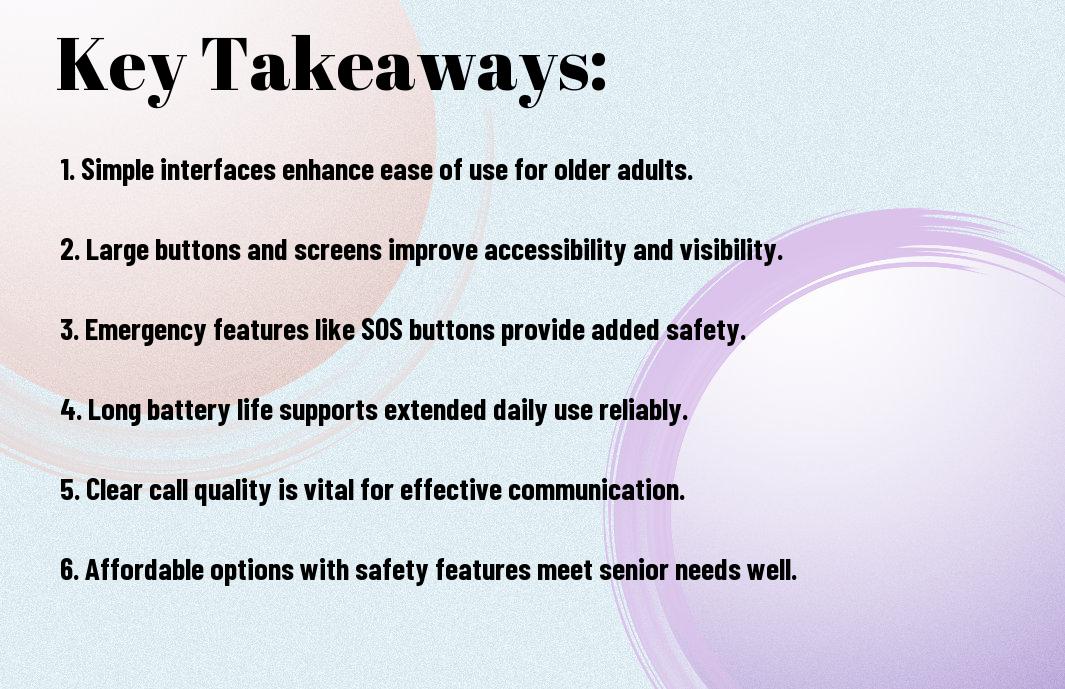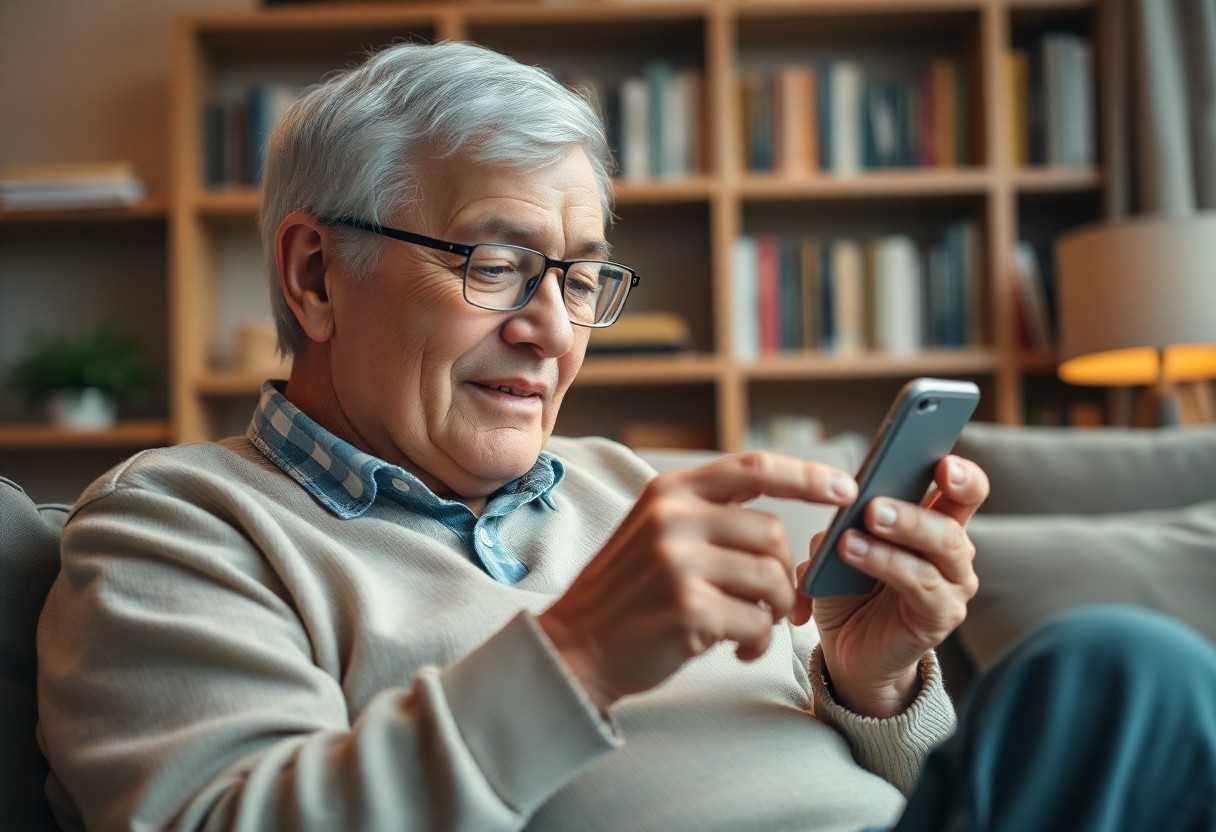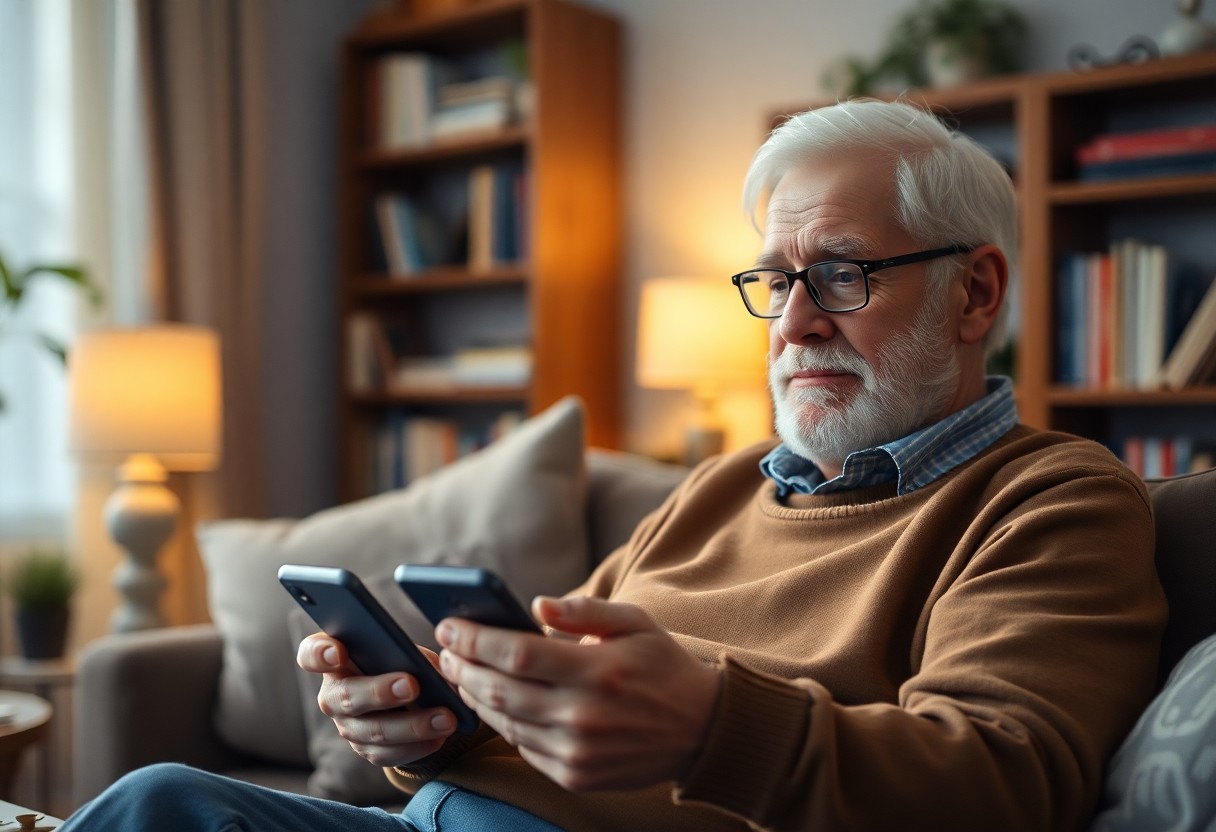
Stay Healthy and Connected: Choosing the Right Phone for Your Well-being (Ages 55-70)
You deserve a phone that fits your lifestyle, offering ease of use and reliable health features. This guide helps you find the best cell phones designed specifically for older adults, focusing on simple interfaces, clear displays, and crucial safety options like emergency SOS and fall detection. By choosing the right device, you can stay connected to loved ones and manage your well-being more effectively, all while enjoying technology tailored to your needs. Explore your options with confidence and make an informed decision that supports both your communication and health priorities.
Key Takeaways:
The best cell phones for older adults offer simplified interfaces and larger buttons or fonts to enhance usability.
Phones with emergency SOS features and fall detection can provide additional safety and peace of mind.
Models that support hearing aid compatibility and clear call quality improve communication for users with hearing difficulties.
Long battery life is an important factor, ensuring the phone remains reliable throughout the day.
Devices designed specifically for seniors often include features like medication reminders and easy access to customer support.
Smartphones with compatibility for wearable health devices allow users to monitor fitness and vital signs more effectively.
Customer service and technical support tailored to seniors can greatly enhance the overall user experience.


Understanding the Needs of Older Adults
Importance of Connectivity
Importance in your life goes beyond just making calls or sending texts. Staying connected helps you maintain relationships, access support networks, and manage your well-being. With the right phone, you can easily communicate with loved ones, health professionals, and caregivers, making it an important tool for your social and emotional health as you navigate the 55 to 70 age range.
Unique Challenges Faced by Seniors
Older adults often experience changes in vision, hearing, and dexterity that can make using standard phones difficult. Navigating complex features or small text can be frustrating, which may discourage using technology that could otherwise support your health and independence.
Seniors face several unique challenges such as reduced vision and hearing, which require phones with larger displays, louder speakers, and adjustable font sizes. Additionally, dexterity limitations make touchscreens and small buttons harder to operate. You might also encounter cognitive changes that increase the need for simplified interfaces and medication reminders. Without appropriate adaptations, these factors can severely limit your ability to benefit from health features or emergency functions, making it important to select devices designed with these aspects in mind.
Key Features to Consider
If you are choosing a phone that supports your health and well-being, focus on features that enhance both usability and safety. Here are the key features you should look for:
Step Counter and Activity Tracking – Helps you stay motivated by monitoring daily steps, calories burned, and distance moved.
Heart Rate Monitor – Provides real-time readings and tracks trends to help you stay informed about your heart health.
Medication Reminders – Sends alerts to assist you in taking medications on time to support your wellness routine.
Fall Detection – Automatically alerts emergency contacts if it detects a sudden fall, enhancing your safety, especially if you live alone.
Integration with Wearables – Syncs data from smartwatches and fitness trackers, offering a comprehensive overview of your health.
Emergency SOS Features – Allows quick access to emergency services with a simple press, often including GPS location sharing.
Senior-Friendly Design – Simplified interfaces, large buttons, and clear menus ensure ease of use.
The The Best Smart Home Devices to Help Aging in Place complement these features perfectly, creating a safer, more connected lifestyle.
User-Friendly Interface
On a phone designed for you, the interface must be simple and intuitive. Large icons, straightforward navigation, and clear menus help prevent frustration and encourage consistent use, allowing you to focus on your health and communication rather than learning complicated controls.
Display Size and Clarity
Clarity in your phone’s display makes a significant difference in your daily experience. A screen with adjustable font sizes and strong brightness settings ensures you can read messages, alerts, and health information comfortably without straining your eyes.
It’s important that the display size is large enough to view details clearly, yet not so bulky that it becomes difficult to handle. High-contrast screens and anti-glare features also improve visibility, especially in various lighting conditions.
Battery Life
An extended battery life means your phone stays ready throughout your busy day without frequent recharging, keeping your health monitoring and emergency features active when you need them most.
In addition to capacity, quick charging capability and optimized power management are valuable. These features make it easier to maintain a reliable connection to your health data and emergency services at all times.
Health and Wellness Tracking
Below the surface, a phone’s ability to track your health metrics consistently can empower you to take a more active role in managing your well-being and staying motivated.
Another advantage is that these devices often synchronize your data with healthcare providers and caregivers, offering a safety net and deeper insight into your health trends, all while enhancing your independence.
Recommended Cell Phones for Older Adults
After exploring the key features that enhance health and well-being, selecting the right phone tailored to your needs is necessary. Your choice should combine user-friendly design with powerful tools that support your lifestyle. Whether you prefer a smartphone with comprehensive health apps or a simpler device focused on ease of use, options abound to help you stay connected and safe.
Smartphones for Seniors
Behind the variety of smartphones designed for you are models that emphasize accessibility and health integration. Devices like the Apple iPhone and Samsung Galaxy offer advanced health tracking features such as fall detection, heart rate monitoring, and medication reminders, paired with easy-to-navigate interfaces. These phones also seamlessly connect with smartwatches to provide a fuller picture of your wellness. With options like ‘Easy Mode’ and voice controls, you get both power and simplicity in one device.
Feature Phones
Beside smartphones, feature phones continue to be a strong choice for those seeking simplicity without sacrificing necessary functions. Devices such as the Jitterbug Smart4 and RAZ Memory Cell Phone prioritize large screens, clear menus, and emergency assistance features like Urgent Response and GPS tracking. These phones offer straightforward communication tools alongside important health-focused capabilities, perfect if you prefer limited distractions or are less comfortable with advanced technology.
Cell phones in this category focus on making your experience as uncomplicated as possible. Their picture-based dialing and simplified interfaces reduce complexity, helping you stay connected with less hassle. Additionally, some models provide remote caregiver management, adding safety for you and peace of mind for your loved ones.
Budget-Friendly Options
Adults seeking affordability don’t have to forgo vital health features. Many budget-friendly phones still include step counters, medication reminders, and emergency SOS functions. These cost-effective options are ideal if you want reliable functionality without a hefty price tag, ensuring you get value with necessary wellness tools.
Understanding your budget alongside your health needs helps you prioritize which features matter most. Some lower-cost smartphones and feature phones offer scalable health packages or app integrations, enabling you to customize your experience. This way, you maintain access to important safety and monitoring tools without overspending.
Enhancing Accessibility
Despite living in an increasingly digital world, you may find certain phone features tricky to navigate. Enhancing accessibility on your mobile device helps ensure you can easily use important health and communication tools without frustration. Modern phones offer a variety of options designed to accommodate different needs, making technology more approachable and comfortable for you as you manage your health and stay connected.
Voice Activation Features
Features like voice commands and virtual assistants allow you to operate your phone hands-free, making calls, sending texts, or accessing apps simply by speaking. This can be especially helpful if you have dexterity challenges or prefer a more natural way to interact with your device. Using voice activation helps you stay engaged with your phone’s health monitoring without navigating complex menus.
Adjustable Settings
Among the most useful accessibility options are adjustable settings for font size, screen brightness, and contrast, which improve readability and reduce eye strain. Many phones allow you to customize these settings easily, ensuring that your screen looks just right for your vision needs. Simplified interfaces or "Easy Modes" also help you focus on vital features without being overwhelmed.
Accessibility settings extend beyond just visuals. You can tailor touch sensitivity, enable hearing aid compatibility, and use screen readers for audio descriptions. These options are designed so you can personalize your experience, making your device feel intuitive and supportive as you monitor your health and communicate with loved ones.
Emergency Features
For your safety, many phones include emergency SOS buttons and fall detection that can automatically notify emergency contacts or services when help is needed. These features provide peace of mind, especially if you live alone, by giving you a quick way to call for assistance in urgent situations.
At the heart of these emergency tools is the ability to send your exact location through GPS, ensuring responders find you quickly. Some devices even allow caregivers remote access to monitor your well-being discreetly. Using a phone with well-designed emergency features helps you maintain independence while being supported by a reliable safety net.

Using Mobile Phones for Health Management
To effectively manage your health with a mobile phone, you should look for devices that offer integrated health features designed to support your well-being. Modern smartphones, especially those with senior-friendly options, can help you stay active, monitor your vital signs, and provide safety measures in emergencies. For instance, if you’re curious about Apple devices, check out Which iPhone Should I Get? | Reviews by Wirecutter for detailed reviews to guide your choice.
Health Monitoring Apps
The variety of health monitoring apps available today allows you to track key metrics like heart rate, steps, and sleep patterns directly from your phone or paired smartwatch. These apps help you maintain a daily overview of your health, motivating you to stay active and alert to changes in your condition over time.
Medication Reminder Features
On many smartphones, you can find or download medication reminder apps that send timely notifications to help you take your prescriptions consistently. This kind of support can give you peace of mind and reduce the chance of missed doses.
This feature often includes customizable alerts, dosage instructions, and refill reminders, ensuring that your medication routine stays organized. Some phones also support integration with health providers or caregivers for added assistance and monitoring.
Emergency SOS Functions
Below are emergency SOS functions that provide quick access to help when you need it most. With a simple press of a button, your phone can alert emergency contacts or services and share your location, giving you added security, especially if you live alone.
In fact, many devices now include fall detection that automatically triggers an emergency call if a sudden fall is detected. This feature can save lives by ensuring prompt assistance during accidents when you may be unable to call for help yourself. Such functions are designed to offer you greater independence and peace of mind.
Tips for Choosing the Right Phone
Not every phone suits your unique health and wellness needs or tech comfort level. When selecting a device, focus on features that genuinely support your lifestyle, such as step counters, heart rate monitors, or medication reminders. Consider these tips:
Prioritize phones with easy-to-read displays and adjustable font sizes.
Look for models offering fall detection and emergency SOS services.
Choose devices compatible with wearables like smartwatches for comprehensive health tracking.
Explore options with simple user interfaces or senior-friendly launchers.
Review privacy policies to protect your sensitive health data.
Recognizing your priorities ensures you select a phone that enhances both your connectivity and well-being. For example, explore The 2 Best Budget Android Phones of 2025 to find affordable options that don’t compromise on health features.
Assessing Personal Preferences
Across the spectrum of options, your comfort with technology and desired features shape the best phone for you. Think about whether you want a device with a simple interface or one with advanced capabilities like ECG monitoring or remote caregiver access. Your daily habits and health focus should guide which functionalities matter most.
Trying Before Buying
After exploring online reviews and specifications, testing phones in-store helps you gauge usability, screen readability, and comfort. Hands-on experience reveals whether the device fits your lifestyle and if the health features meet your needs.
Choosing to spend time trying phones before purchase can prevent frustration later. It allows you to assess physical factors like button size and tactile feedback, as well as how intuitive the navigation feels. Engaging with staff can also provide demonstrations of health apps and emergency functions, giving you confidence in your decision.
Seeking Guidance from Family
Against the temptation to decide alone, involving family can offer valuable insights into which health features and safety options may benefit you most. Their perspective can help balance ease of use with advanced monitoring capabilities.
In fact, family members often assist with setup and troubleshooting, making it easier to adopt new technology. Their involvement also enhances safety when phones have GPS tracking or emergency alerts, providing peace of mind for both you and your loved ones.
Final Words
From above, the guide at The New York Times Wirecutter on the best cell phones for older adults offers valuable insights to help you choose a device tailored to your specific needs. It highlights options that balance ease of use, health-related features, and affordability, ensuring you stay connected and supported. By considering their expert recommendations, you can confidently select a phone that enhances your daily life, supports your well-being, and keeps you engaged with loved ones and important health tools.
FAQ
Q: What features make a cell phone suitable for older adults?
A: Phones designed for older adults often have larger buttons and screens, simplified interfaces, and louder speakers. They may also include health-related features such as emergency SOS buttons, medication reminders, step counting, and fall detection. Accessibility options like adjustable font sizes and voice control are also common to accommodate various needs.
Q: Are smartphones or simpler feature phones better for seniors?
A: It depends on the user's comfort level with technology and their specific needs. Smartphones offer a vast range of features including health tracking and internet access, but they can be more complex. Feature phones are simpler to use, with fewer distractions, making them a good choice for those who primarily want to make calls and send texts.
Q: How reliable are fall detection and emergency SOS features in phones for seniors?
A: Many phones and smartwatches designed for seniors incorporate fall detection technology that can automatically alert emergency contacts or services if a fall is detected. While these features provide added safety, it’s important to review how each device works and test them to ensure they respond accurately in case of an emergency.
Q: What should I consider regarding privacy with health-monitoring phones?
A: When choosing a phone with health features, it’s important to select reputable brands that use secure data encryption and offer transparent privacy policies. Understanding how your health data is collected, stored, and shared will help you make an informed decision and safeguard your personal information.
Q: Can phones for older adults integrate with wearable health devices?
A: Yes, many modern smartphones can pair with wearable devices such as smartwatches and fitness trackers. This integration allows users to consolidate activity, heart rate, and sleep data in one place, offering a more comprehensive view of their health and easing communication with healthcare providers.
Q: What accessibility features should seniors look for in a phone?
A: Seniors should look for phones with adjustable font sizes, high-contrast displays, and simplified user interfaces. Features such as voice control and loud, clear speakers can help those with vision or hearing challenges. Some phones offer "easy modes" or launcher apps designed specifically for easier navigation.
Q: Are there specific phone models recommended for seniors focusing on health and ease of use?
A: Yes, some phones like the Jitterbug Smart4 are tailored for older adults with simplified menus and health support packages. Apple iPhones and Samsung Galaxy phones also provide extensive health monitoring features and accessibility options. Additionally, phones like the RAZ Memory Cell Phone offer cognitive-friendly designs with GPS tracking and medication reminders.
